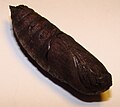| Mimas tiliae | |
|---|---|
 | |
 | |
| Scientific classification | |
| Kingdom: | Animalia |
| Phylum: | Arthropoda |
| Class: | Insecta |
| Order: | Lepidoptera |
| Family: | Sphingidae |
| Genus: | Mimas |
| Species: | M. tiliae |
| Binomial name | |
| Mimas tiliae | |
| Synonyms | |
| |
Mimas tiliae, the lime hawk-moth, is a moth of the family Sphingidae. It is found throughout the Palearctic region and the Near East, and in northern Spain (Europe). The species was first described by Carl Linnaeus in his 1758 10th edition of Systema Naturae.
Contents

This species is quite variable, though not confusable with any other sphingid of the Palearctic in its markings, the ground colour of the forewings being pinkish or buff, darker towards the tornus, marked with one or two dark green or brown blotches which are sometimes merged to form a continuous band across the middle of the forewing. The hindwings are plainer, grey or buffish brown. The wingspan is 70–80 millimetres (2+3⁄4–3+1⁄8 in). It exhibits sexual dimorphism, the male usually being smaller but more strongly marked than the female. Usually, the forewing ground colour is brownish in females and decidedly green in males, but there are many exceptions. The female abdomen is straight and fat with fully formed eggs, which are already present when the female emerges (as in all species of Smerinthini). The male abdomen, on the other hand, is strongly curved and slender.
Forms include
- f. brunneaBartel ground colour brown
- f. pallidaTutt ground colour grey
- f. lutescensTutt yellow
- f. virescensTutt ground colour green
- f. transversaTutt dark median band of the forewing entire
- f. tiliae dark median band narrowly separated
- f. obsoletaClark dark median band completely absent
This moth flies at night in May and June, [Note 1] and is attracted to light. The adults do not feed.
- Caterpillar/Larva
- Chrysalis/Pupa
- Mimas tiliae♂ – MHNT
- Mimas tiliae♂ underside – MHNT
- Mimas tiliae♀ – MHNT
- Mimas tiliae♀ underside – MHNT
The larva is green with yellow and red markings along the side and a blue horn at the hind end, typical of the family. It feeds mainly on lime but has also been recorded feeding on other trees and shrubs (see list below). The colour changes to purple-grey when ready to pupate, at which point the larvae wander in search of a pupation site. [2] The species overwinters as a pupa in the soil at the base of its host tree.





